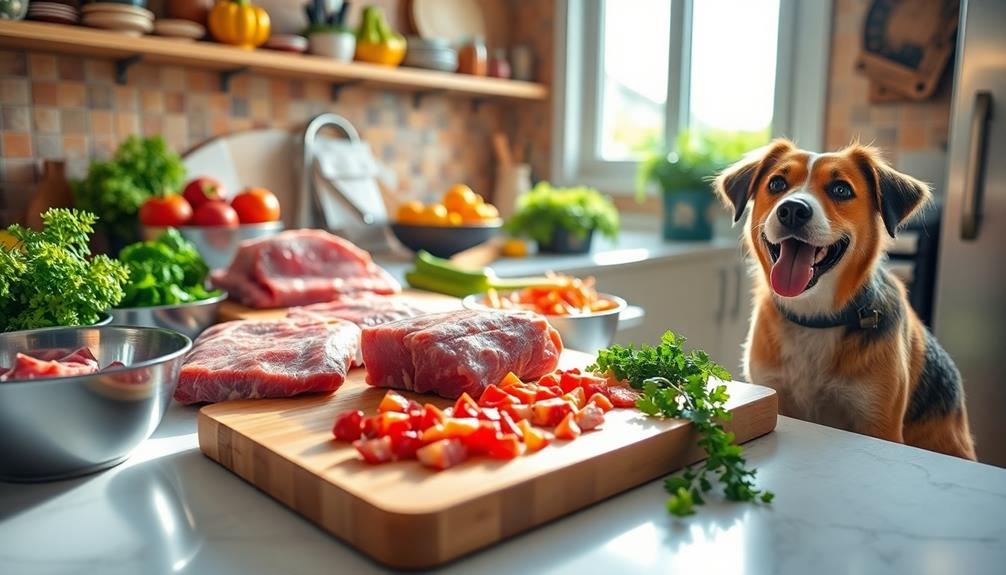Shifting your puppy to a raw food diet can boost their health and energy. Start by introducing new foods gradually over 7-10 days, beginning with 75% kibble and 25% raw. Monitor your puppy's digestion; if issues arise, slow down the process. Offer meals twice daily and consider enhancing raw dishes with low-sodium bone broth or cheese to make them more appealing. Also, maintain a consistent feeding schedule and a low-traffic area for meals. This gradual approach helps avoid digestive upset. There's much more to discover about ensuring a safe and successful shift for your puppy.
Key Takeaways
- Gradually transition puppies to raw food over 7-10 days to support their developing digestive systems and prevent digestive issues.
- Introduce raw food by starting with a 75% kibble and 25% raw ratio, adjusting every few days until fully raw.
- Enhance raw meals with toppings like low-sodium bone broth or cheese to increase appeal and encourage acceptance.
- Maintain a consistent feeding schedule, ideally twice daily, and create a quiet feeding environment to minimize distractions.
- Monitor for signs of food intolerance and consult veterinarians for tailored feeding plans to ensure balanced nutrition.
Understanding Puppy Digestion
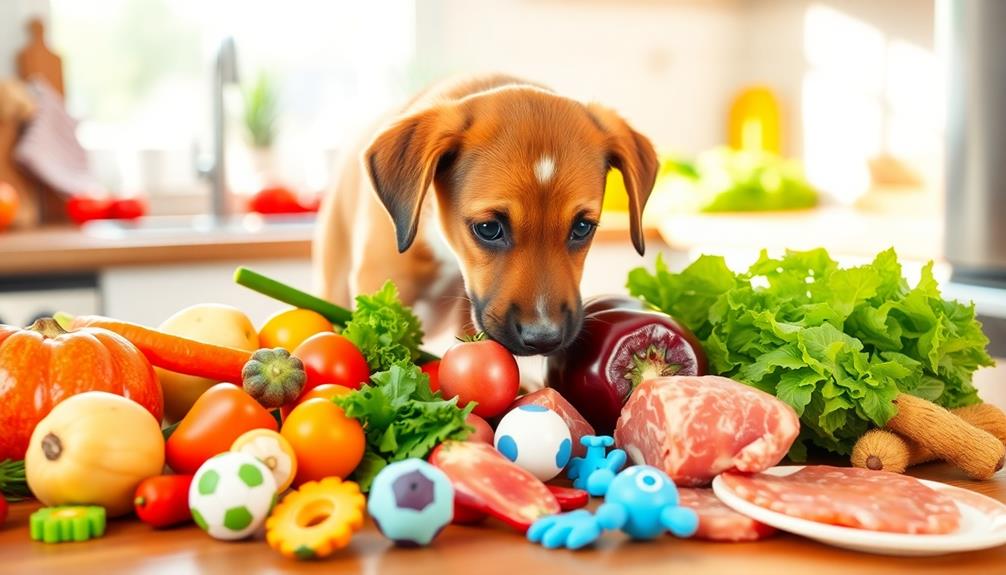
Understanding puppy digestion means recognizing that their bodies are still developing and require special attention.
Puppies have a shorter digestive tract compared to adult dogs, which means their digestion process is quicker and they need more frequent meals. When shifting to raw dog food, you must keep in mind that their developing digestive system can be sensitive to changes, making it essential to introduce new foods gradually over a 7-10 day period.
The balance of bacteria in a puppy's gut plays a critical role in proper digestion and a strong immune system. An imbalance can lead to digestive issues like diarrhea or vomiting, which you definitely want to avoid.
Puppies also have higher protein and fat requirements necessary for their growth and development, so it's important to pay close attention to their nutrient intake during these shifts.
To support healthy puppy digestion, establish a consistent feeding schedule that accommodates their energy needs.
Transition Methods Overview

Shifting your puppy to a raw food diet can be an exciting journey, but it's important to choose the right method to guarantee a smooth adjustment. The two primary methods for changing over are cold turkey and a gradual shift.
Cold turkey involves an immediate switch to raw food, which can be risky, especially for puppies with sensitive stomachs. A gradual shift is typically safer, taking about 7-10 days to allow your puppy's digestive system to adapt.
Start with a mix of 75% kibble and 25% raw food, then adjust the ratios every few days until your puppy is fully on a raw diet by day 10. If your puppy shows signs of digestive issues, slow down the changeover and begin with smaller amounts of raw food, carefully monitoring for any reactions.
Before introducing raw food, it's a good idea to skip a meal to encourage appetite. During this period, maintain a consistent feeding schedule and refrain from giving treats outside of meal times to help your puppy accept the new diet.
This structured approach will aid in a successful shift to raw food.
Practical Feeding Tips
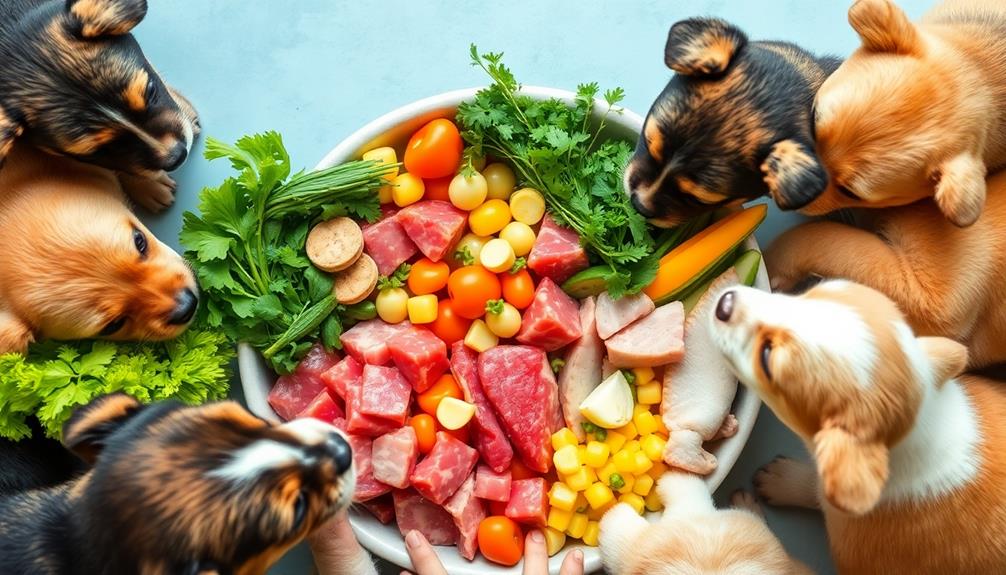
When switching your puppy to a raw food diet, it's essential to shift gradually, ensuring their digestive system adjusts smoothly.
Set a consistent meal schedule, ideally twice a day, to help your puppy develop a healthy appetite.
To make raw meals more appealing, consider adding tasty toppings like low-sodium bone broth or cheese.
Gradual Food Transition
Shifting your puppy to a raw food diet should be a gradual process to guarantee their digestive system adjusts comfortably. Start the changeover to raw dog food over a 7-10 day period.
For the first three days, mix 75% of their current kibble with 25% raw food. This helps ease your puppy into their new diet. From days four to six, change the ratio to 50% raw and 50% kibble, then move to 75% raw and 25% kibble from days seven to nine. By day ten, aim for a 100% raw diet, but make adjustments based on your puppy's digestive response.
An important thing to remember is to introduce one new protein source at a time. This way, you can monitor their reaction for any signs of digestive upset or allergies.
Consistency is key, so maintain a regular feeding schedule. Provide meals in a quiet area and limit treat offerings to enhance acceptance of the new food.
This complete guide will help you successfully changeover to raw dog food while keeping your puppy's digestive tract healthy and happy.
Meal Scheduling Strategies
Establishing a consistent feeding schedule is essential for your puppy's change to a raw food diet. Aim to offer meals twice daily, ideally in the morning and evening. This promotes appetite and establishes a routine. Raw meals should not be left out for more than 20 minutes to guarantee freshness and prevent bacterial growth.
To support this change, consider the following meal scheduling strategies:
| Strategy | Description |
|---|---|
| Feeding Frequency | Offer meals twice a day to establish a regular routine. |
| Meal Duration | Remove raw meals after 20 minutes to maintain safety. |
| Skipping Meals | Skip a meal before introducing raw food to increase appetite. |
| Safe Feeding Area | Create a low-traffic area to minimize distractions. |
| Treat Reduction | Gradually eliminate treats to focus on raw meals. |
Enhancing Food Appeal
Enhancing your puppy's raw food experience can make mealtime more enjoyable and encourage healthy eating habits. To boost the appeal of raw food, consider adding toppings like cheese, low-sodium bone broth, or even canned sardines. These additions can make meals more enticing and palatable.
Lightly searing the meat before serving releases delicious aromas, making it more tempting. As your puppy gets used to raw food, gradually reduce the searing.
Don't hesitate to experiment with various flavor boosters, such as goat's milk or pumpkin puree, to discover what excites your puppy. Incorporating a variety of proteins—like chicken, beef, and fish—keeps meals interesting and prevents dietary boredom.
Additionally, serve your puppy's meals in a safe, low-traffic area to minimize distractions and reduce anxiety. This environment can help your puppy feel comfortable while adapting to a new raw food diet.
Nutritional Benefits of Raw Food
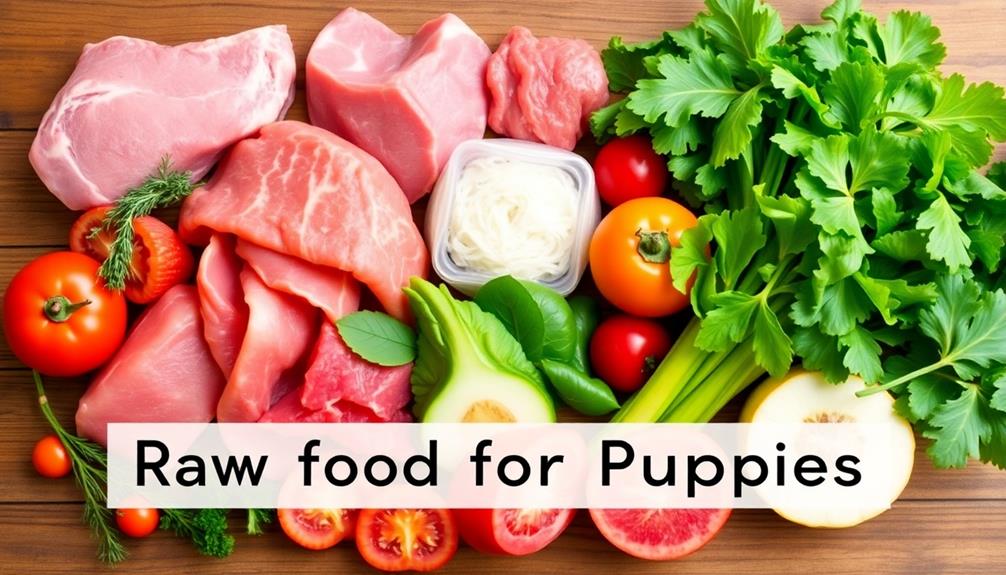
When you choose raw food for your puppy, you're boosting their nutrient absorption considerably.
The natural enzymes in raw ingredients can improve digestive health, helping your pup get the most out of their meals.
This means healthier growth and more energy for all their playful adventures.
Enhanced Nutrient Absorption
Raw food diets greatly boost nutrient absorption, making them an excellent choice for puppies. By providing high-quality proteins from meats, organs, and bones, you're setting your puppy up for ideal growth and muscle development. The moisture-rich content in raw dog food not only enhances nutrient absorption but also promotes better hydration, reducing the need for extra water intake.
Incorporating fresh fruits and vegetables into your puppy's diet supplies essential vitamins and minerals, strengthening their immune system and overall health. Additionally, important fatty acids from fish oil and animal fats support healthy skin and coat development, significant during these growth stages.
Here's a quick overview of the benefits of raw food:
| Nutrient | Benefit | Source |
|---|---|---|
| High-Quality Proteins | Muscle development & growth | Meats, organs, bones |
| Important Fatty Acids | Healthy skin & coat | Fish oil, animal fats |
| Fresh Fruits & Vegetables | Immune system support | Various fruits & veggies |
A balanced raw diet also guarantees appropriate calcium and phosphorus ratios, supporting ideal bone health, especially important for large and giant breed puppies.
Improved Digestive Health
A well-balanced raw food diet greatly boosts your puppy's digestive health by promoting a healthy gut flora balance. This balance is fundamental for a symbiotic relationship within your puppy's gastrointestinal tract, which can help reduce common digestion issues like diarrhea and vomiting.
When you introduce raw food gradually, you support your puppy's shift to this diet, minimizing the risk of abrupt changes that could upset their stomach. The moisture content in raw food also plays an essential role in maintaining hydration and peak digestion, which helps prevent constipation.
Rich in natural enzymes and probiotics, raw diets aid in breaking down food effectively, enhancing nutrient absorption. This means your puppy gets the most out of every meal.
Moreover, incorporating raw meat, organs, and bones guarantees your puppy is receiving high-quality proteins and important fatty acids. These nutrients are significant for building strong muscles and supporting a healthy digestive system as your puppy grows.
Addressing Common Concerns

While many pet owners worry about the potential risks of feeding their puppies a raw diet, these concerns can often be addressed with proper precautions.
First, focus on safe handling practices. Always wash your hands and use separate utensils for raw food to minimize bacterial contamination risks. During the shift to a raw diet, keep an eye out for signs of food intolerance or allergies, such as digestive upset or changes in stool consistency.
To avoid nutritional deficiencies or excesses, it's essential to guarantee your puppy receives a balanced raw diet. This means including proteins, healthy fats, vitamins, and minerals tailored to their specific needs.
Sourcing high-quality ingredients is also important—fresh, reputable sources will help assure that your puppy gets the nutrients necessary for healthy growth and development.
Lastly, don't forget the significance of regular veterinary check-ups during this shift phase. Monitoring your puppy's health, weight, and nutritional status is critical, allowing you to make timely adjustments to their diet if needed.
Resources for Successful Transition
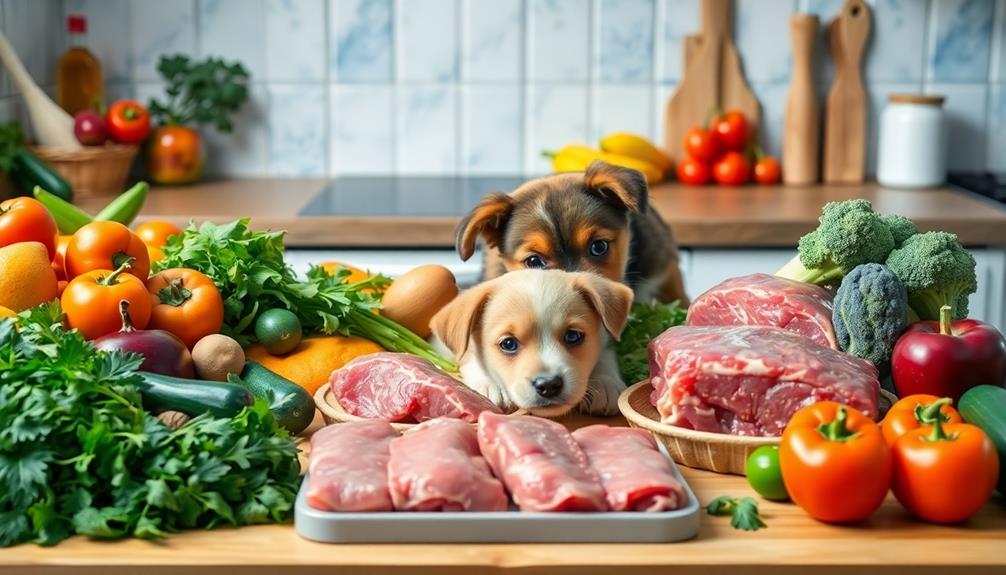
Finding the right resources can make all the difference in successfully shifting your puppy to a raw food diet. Start by consulting with a veterinarian or canine nutritionist to create a tailored feeding plan that meets your puppy's unique nutritional needs. They can help you navigate the change and guarantee your puppy's health remains a priority.
Additionally, incorporating a balanced diet with whole foods is essential for overall health and can parallel the principles of 10 Kg weight loss meal plan for human nutrition.
Online forums and communities dedicated to raw feeding are invaluable. You can share experiences and gather advice from other pet owners who've successfully altered their dogs to a raw diet. Joining Facebook groups focused on raw feeding discussions also provides insights and support throughout the process.
Don't forget to access books and articles that cover raw dog food nutrition and safe handling practices. This knowledge will empower you to make informed decisions about feeding your puppy.
Frequently Asked Questions
How to Transition a Puppy to a Raw Diet?
To shift your puppy to a raw diet, start with a mix of kibble and raw food, gradually increasing the raw portion. Monitor their reactions and consult a vet for balanced nutrition tailored to their needs.
Can You Wean Puppies on Raw Food?
Imagine your puppy enthusiastically nibbling on fresh, raw meat. Yes, you can wean puppies onto raw food. Just start slowly, ensuring you balance their diet and monitor for any digestive issues along the way.
Is a Raw Diet Ok for Puppies?
Yes, a raw diet can be okay for puppies if it's balanced and meets their nutritional needs. Consult your vet, shift gradually, and monitor for any digestive issues or allergies during the process.
How Long Does It Take for a Dog to Adjust to a Raw Diet?
Imagine your dog savoring fresh, vibrant meals. Typically, it takes about 7-10 days for your dog to adjust to a raw diet. Gradually increase the raw food while watching for any digestive changes.
Conclusion
Shifting your puppy to a raw food diet can be a rewarding experience that boosts their health and energy. For instance, consider Max, a once-sleepy Golden Retriever who thrived after switching to raw food. His coat became shinier, and he gained a playful spirit. By following the tips outlined in this guide and addressing your concerns, you can guarantee a smooth shift for your puppy, giving them the best start in life and a happier, healthier future.





